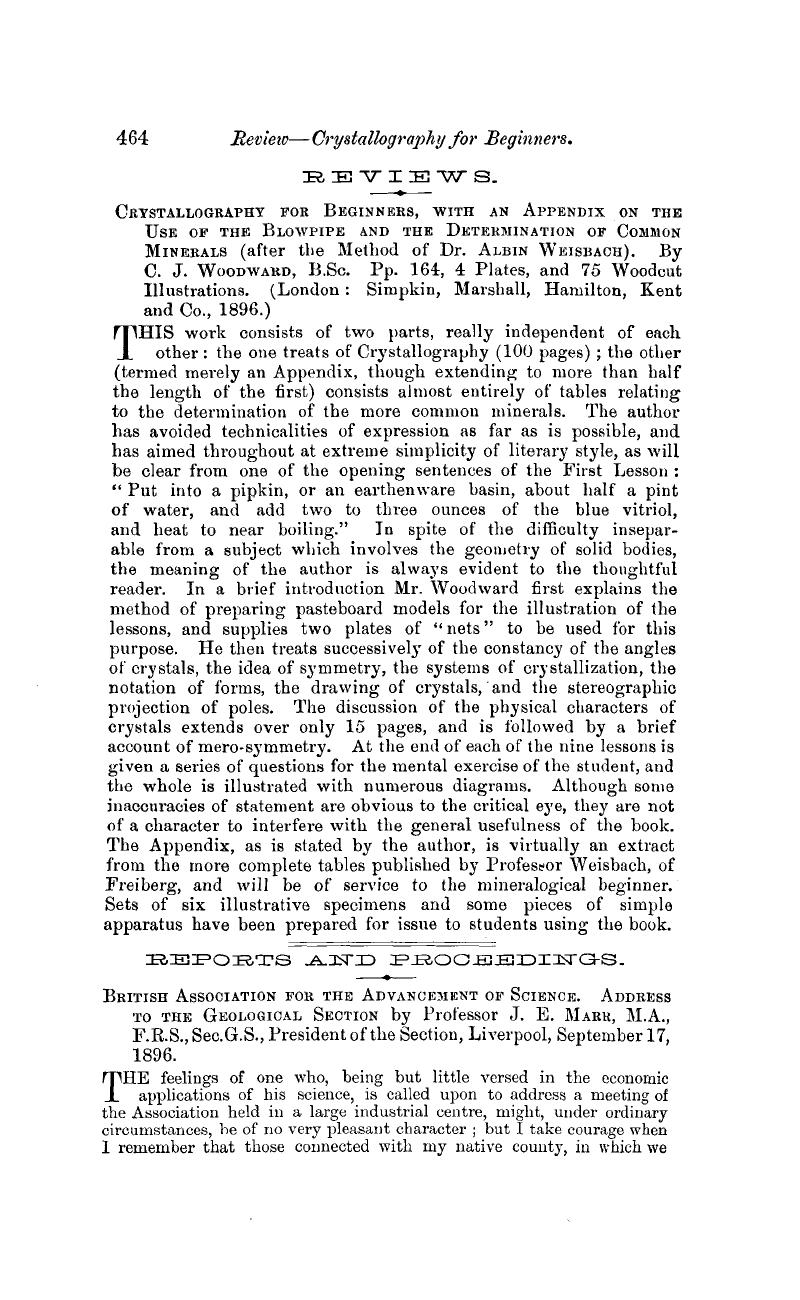No CrossRef data available.
Article contents
Abstract

- Type
- Reports and Proceedings
- Information
- Copyright
- Copyright © Cambridge University Press 1896
References
page 466 note 1 Dr. C. D. Walcott, in his monograph on “The Fauna of the Lower Cambrian or Olenellus Zone" (Washington, 1890), records the following great groups as represented in the Olenellus beds of America: Spongiæ, Hydrozoa, Actinozoa, Echinodermata, Annelida? (trails, burrows, and tracks), Brachiopoda, Lamellibranchiata, Gasteropoda, Pteropoda, Crustacea, and Trilobita. Others are known as occurring in beds of the same age in the Old World.
page 467 note 1 See Noetling, F., “On the Cambrian Formation of the Eastern Salt Range”: Records Geol. Survey India, vol. xxvii, p. 71.Google Scholar
page 467 note 2 Matthew, G. F., “The Protolenus Fauna”: Trans. New York Acad. of Science, 1895, vol. xiv, p. 101.Google Scholar
page 467 note 3 Sir A. Geikie, “Annual Report of the Geological Survey [United Kingdom] … for the year ending December 31, 1893.” London, 1894.
page 468 note 1 W. Keeping, Sedgwick Essay: “The Fossils and Palæontological Affinities of the Neocomian Deposits of Upware and Brickhill.” Cambridge, 1883.
page 470 note 1 Brögger, W. C., Nyt. Mag. for Naturvidensk., vol. xxx (1886), p. 79.Google Scholar
page 470 note 2 Davis, W. M., Geograph. Journ., vol. v (1895), p. 127.CrossRefGoogle Scholar
page 470 note 3 It is desirable that the boulders of sedimentary rock imbedded in the drifts of East Anglia should be carefully examined, and fossils collected from them. The calcareous strata associated with the Alum Shales of Scandinavia and the strata of the Orthoceras Limestone of that region may be expected to be represented amongst the boulders.
page 471 note 1 Nicholson and Lydekker, “Manual of Palæontology,” chap. ii.
page 472 note 1 Similar knoll-like masses have been described in this country by Mr. R. H. Tiddeman, as occurring in the Craven district of Yorkshire, but he does not attribute their formation to coral-growth to any great extent.
page 473 note 1 SirGeikie, A., Quart. Journ. Geol. Soc., vols. xlvii and xlviii.Google Scholar
page 474 note 1 Alfred Harker, Sedgwick Essay for 1888 (Camb. Univ. Press, 1889).
page 474 note 2 Barrow, G., Quart. Journ. Geol. Soc., vol. xlix (1893), p. 330.CrossRefGoogle Scholar
page 474 note 3 David, T. W. E., “Evidences of Glacial Action in Australia in Permo-Carboniferous Time”: Quart. Journ. Geol. Soc., vol. lii, p. 289.Google Scholar
page 475 note 1 Gray, J. W. and Kendall, P. F., “The Cause of an Ice Age”: Brit. Assoc. Rep. (1892), p. 708.Google Scholar
page 475 note 2 Neumayr, M., “Ueber klimatische Zonen während der Jura- und Kreidezeit”: Denkschr. der math -naturwissen. Classe der k. k. Akad. der Wissenschaften, vol. xlvii. Vienna, 1883.Google Scholar
page 477 note 1 Mojsisovics, E., Abhandl. der k. k. geol. Reichsanst., vol. vi (1893).Google Scholar
page 477 note 2 Buckman, S. S., Quart. Journ. Geol. Soc., vol. li (1895), p. 456.Google Scholar
page 477 note 3 Nicholson, H. A. and Marr, J. E., Geol. Mag., Dec. 4, Vol. II (1895), p. 531.Google Scholar
page 477 note 4 Beecher, C. E., “Development of the Brachiopoda”: Amer. Journ. Sci., ser. iii, vol. xli (1891), p. 343, and vol. xliv (1892), p. 133.CrossRefGoogle Scholar
page 477 note 5 Jackson, R. T., “Phylogeny of the Pelecypoda”, Mem. Boston Soc. Nat. Hist., vol. iv (1890), p. 277Google Scholar; and “Studies of Palæechinoidea”, Bull. Geol. Soc. Amer., vol. vii (1896), p. 171.Google Scholar
page 477 note 6 E.g. the following papers treating of the Cephalopoda: Hyatt, A., “Genesis of the Arietidæ”, Smithsonian Contributions, vol. xxvi (1889)Google Scholar; Neumayr, M., Jura-Studien, I, “Ueber Phylloceraten”, Jahrb. der k. k. Geol. Reichsanst., vol. xxi (1871), p. 297Google Scholar; L. Würtenberger, “Studien über die Stammesgeschichte der Ammoniten,” Leipzig, 1880; Buckman, S. S., “A Monograph of the Inferior Oolite Ammonites of the British Islands”, 1887, Monogr. Palæontographical Soc.Google Scholar


